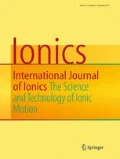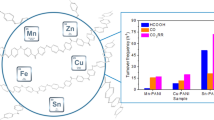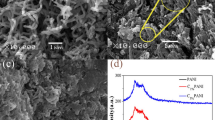Abstract
A novel nitroxide radical-containing aniline, 4-(6-(2-amino-phenol-9H-yl)hexanoyloxy)-2,2,6,6-tetramethylpiperidin-1-yloxy (AnT), was synthesized, and the copolymers of AnT and aniline (P (An-co-AnT)) were then prepared by chemical oxidative polymerization. The introduction of polyaniline (PAn) skeleton in copolymers improved the charge migration along polymer backbone, and the increased ratio of An/AnT monomer makes PAn’s anodic peak in copolymers shift to negative potential and the redox peaks for the nitroxide radical shift to the positive potential. Also, P (An-co-AnT) exhibited a gradually increased charged specific capacity from 120.1 to 141.0 mAh g−1 with increasing the feeding ratio of AnT/An, while the discharge specific capacity presented an opposite result. Specially, P (An-co-AnT) exhibited an obvious charge voltage platform and an even improved cycling stability than that of PAn in the high feeding ratio of AnT/An, and after 20 cycles, the discharge capacity of P (An-co-AnT) (1:1 ([An]/[AnT])) still maintained 82.7 % of the capacity obtained at the initial cycle.









Similar content being viewed by others
References
Yanliang L, Zhanliang T, Jun C (2012) Organic electrode materials for rechargeable lithium batteries. Adv Energy Mater 2:742–769
Park KS, Schougaard SB, Goodenough JB (2007) Conducting-polymer/iron-redox-couple composite cathodes for lithium secondary batteries. Adv Mater 19:848–851
Oyama N, Tatsuma T, Sato T, Sotomura T (1995) Dimercaptan–polyaniline composite electrodes for lithium batteries with high energy density. Nature 373:598–600
Lin HC, Li CC, Lee JT (2011) Nitroxide polymer brushes grafted onto silica nanoparticles as cathodes for organic radical batteries. J Power Sources 196:8098–8103
Simonet J (2013) Graphene attached to glassy carbon surfaces. From Simple Deposition to Redox Polymer Cathodic Generation. Electrochem Commun 36:62–65
Tamura K, Akutagawa N, Satoh M, Wada J, Masuda T (2008) Charge/discharge properties of organometallic batteries fabricated with ferrocene-containing polymers. Macromol Rapid Commun 29:1944–1949
Yao M, Senoh H, Sakai T, Kiyobayashi T (2012) Redox active poly(N-vinylcarbazole) for use in rechargeable lithium batteries. J Power Sources 202:364–368
Yao M, Senoh H, Yamazaki S, Siroma Z, Sakai T, Yasuda K (2010) High-capacity organic positive-electrode material based on a benzoquinone derivative for use in rechargeable lithium batteries. J Power Sources 195:8336–8340
Nakahara K, Iwasa S, Satoh M, Morioka Y, Iriyama J, Suguro M, Hasegawa E (2002) Rechargeable batteries with organic radical cathodes. Chem Phys Lett 359:351–354
Nakahara K, Iriyama J, Iwasa S, Suguro M, Satoh M, Cairns E (2007) High-rate capable organic radical cathodes for lithium rechargeable batteries. J Power Sources 165:870–873
Bugnon L, Morton C, Novak P, Vetter J, Nesvadba P (2007) Synthesis of poly(4-methacryloyloxy-TEMPO) via group-transfer polymerization and its evaluation in organic radical battery. Chem Mater 19:2910–2914
Suguro M, Iwasa S, Kusachi Y, Morioka Y, Nakahara K (2007) Cationic polymerization of poly(vinyl ether) bearing a tempo radical: a new cathode-active material for organic radical batteries. Macromol Rapid Commun 28:1929–1933
Oyaizu K, Suga T, Yoshimura K, Nishide H (2008) Synthesis and characterization of radical-bearing polyethers as an electrode-active material for organic secondary batteries. Macromolecules 41:6646–6652
Qu JQ, Katsumata T, Satoh M, Wada J, Masuda T (2009) Poly(7-oxanorbornenes) carrying 2,2,6,6-tetramethylpiperidine-1-oxy(TEMPO) radicals: synthesis and charge/discharge properties. Polymer 50:391–396
Suga T, Ohshiro H, Sugita S, Oyaizu K, Nishide H (2009) Emerging N-type redox-active radical polymer for a totally organic polymer-based rechargeable battery. Adv Mater 21:1627–1630
Qu JQ, Khan FZ, Satoh M, Wada J, Hayashi H, Mizoguchi K, Masuda T (2008) Synthesis and charge/discharge properties of cellulose derivatives carrying free radicals. Polymer 49:1490–1496
Suguro M, Mori A, Iwasa S, Nakahara K, Nakano K (2009) Syntheses and electrochemical properties of TEMPO radical substituted silicones: active material for organic radical batteries. Macromol Chem Phys 210:1402–1407
Yang LL, Qiu WH, Liu QG (1996) Polyaniline cathode material for lithium batteries. Solid State Ionics 86–88:819–824
Posudievsky OY, Kozarenko OA, Dyadyun VS, Koshechko VG, Pokhodenko VD (2012) Electrochemical performance of mechanochemically prepared polyaniline doped with lithium salt. Synth Met 162:2206–2211
Bhadra S, Khastgir D, Singha NK, Lee JH (2009) Progress in preparation, processing and applications of polyaniline. Prog Polym Sci 34:783–810
He BL, Dong B, Wang W, Li HL (2009) Performance of polyaniline/multi-walled carbon nanotubes composites as cathode for rechargeable lithium batteries. Mater Chem Phys 114:371–375
MacDiarmid AG, Ching JC, Richter JC, Epstein AJ (1987) Polyaniline: a new concept in conducting polymers. Synth Met 18(2):285–290
Ram MK, Carrara S, Paddeu S, Nicolini C (1997) Effect of annealing on physical properties of conducting poly(ortho-anisidine) Langmuir-Bloodgett films. Thin Solid Films 302:89–97
Kurosaki T, Takahashi O, Okawara M (1974) Polymers having stable radicals. II. Nitroxyl polymers from 4-methacryloyl derivatives of 1-hydroxy-2,2,6,6,-tetramethylpiperidine. J Polym Sci: Polym Chem Ed 12:1407–1420
Rodrigues S, Munichandraiah N, Shukla AK (1999) AC impedance and state-of-charge analysis of a sealed lithium-ion rechargeable battery. J Solid State Electrochem 3:397–405
Nobili F, Croce F, Scrosati B, Marassi R (2001) Electronic and electrochemical properties of LixNi1-yCoyO2 cathodes studied by impedance spectroscopy. Chem Mater 13:1642–1646
Acknowledgments
The Project was supported by the National Science Foundation of China (Grant No. 51573099), the Natural Science Foundation of Liaoning Province, China (Grant No.2015020441), and the National Science Foundation for Post-doctoral Scientists of China (Grant No. 2015M570524). This work also was supported by the analysis and testing foundation of the Zhejiang University of Technology.
Author information
Authors and Affiliations
Corresponding author
Rights and permissions
About this article
Cite this article
Xu, L., Ji, L., Wang, G. et al. A novel nitroxide radical polymer-containing conductive polyaniline as molecular skeleton: its synthesis and electrochemical properties as organic cathode. Ionics 22, 1377–1385 (2016). https://doi.org/10.1007/s11581-016-1663-8
Received:
Revised:
Accepted:
Published:
Issue Date:
DOI: https://doi.org/10.1007/s11581-016-1663-8




